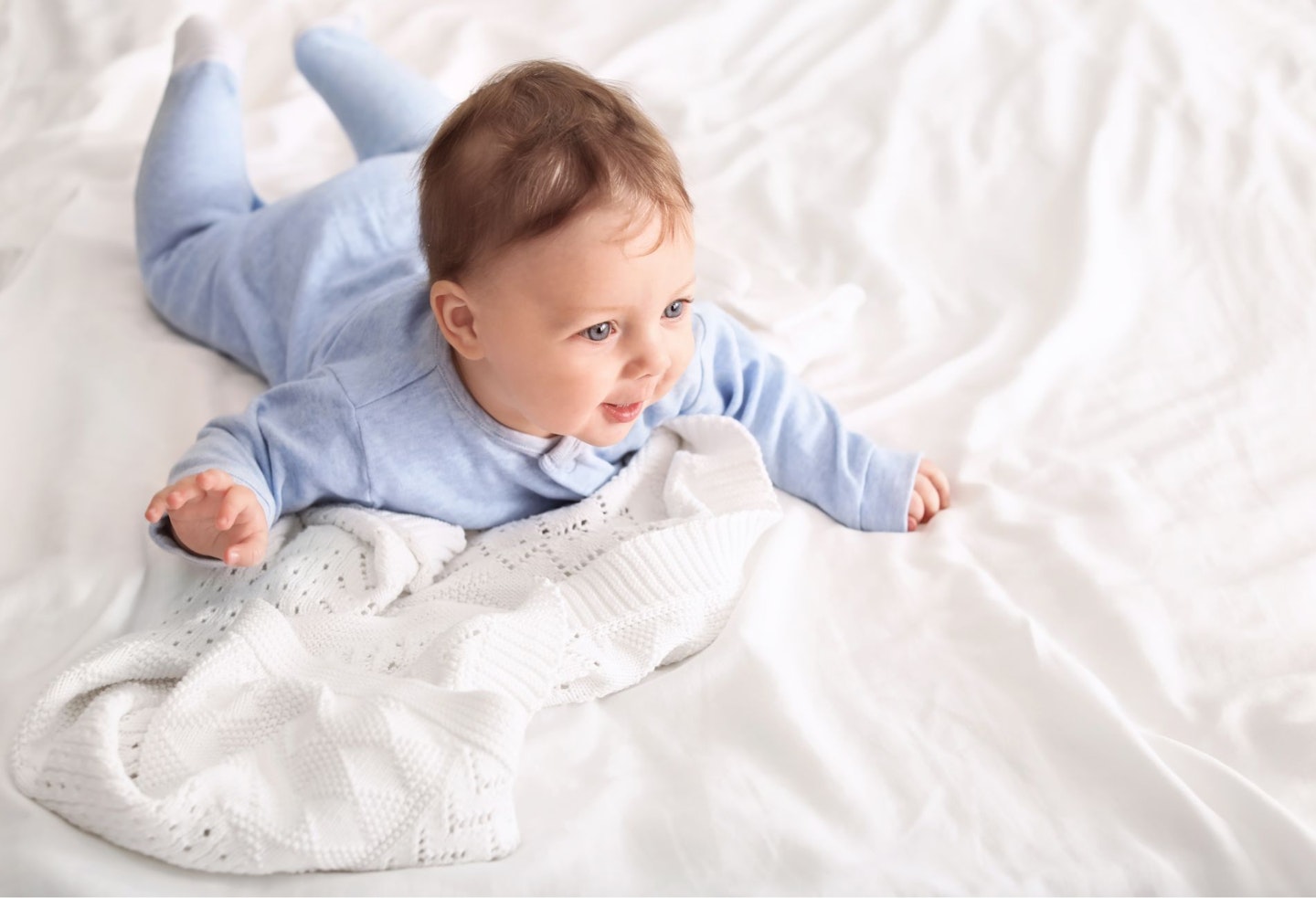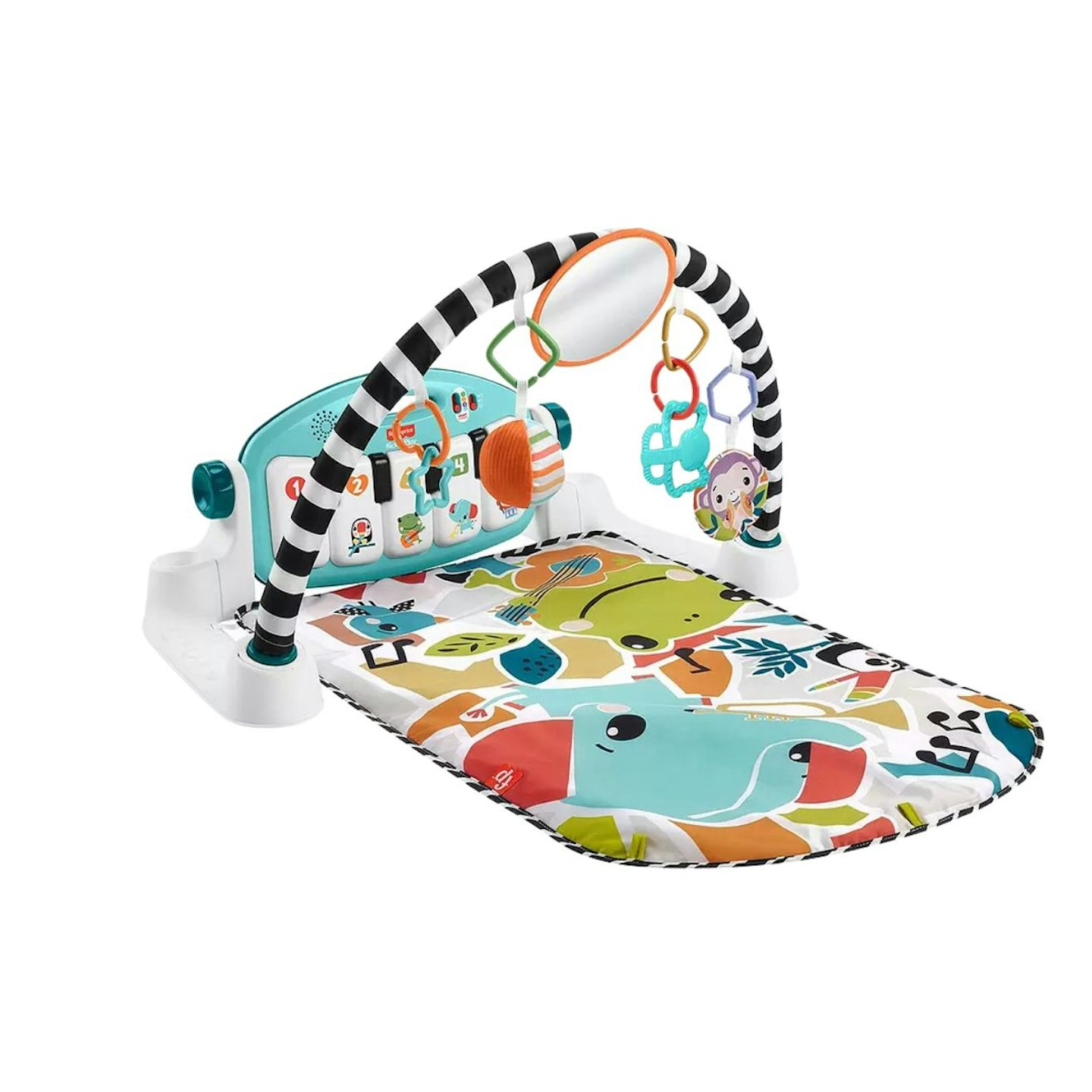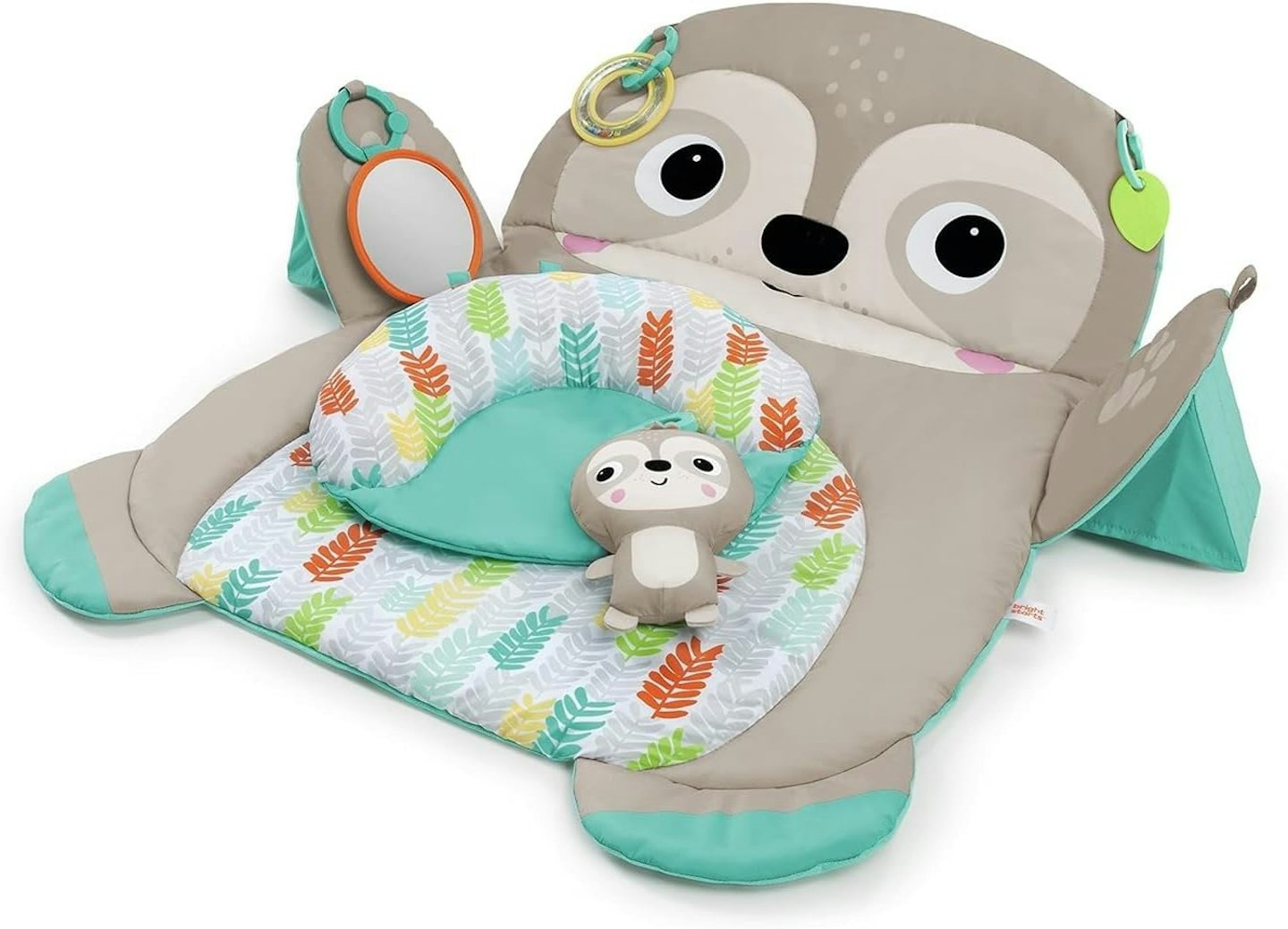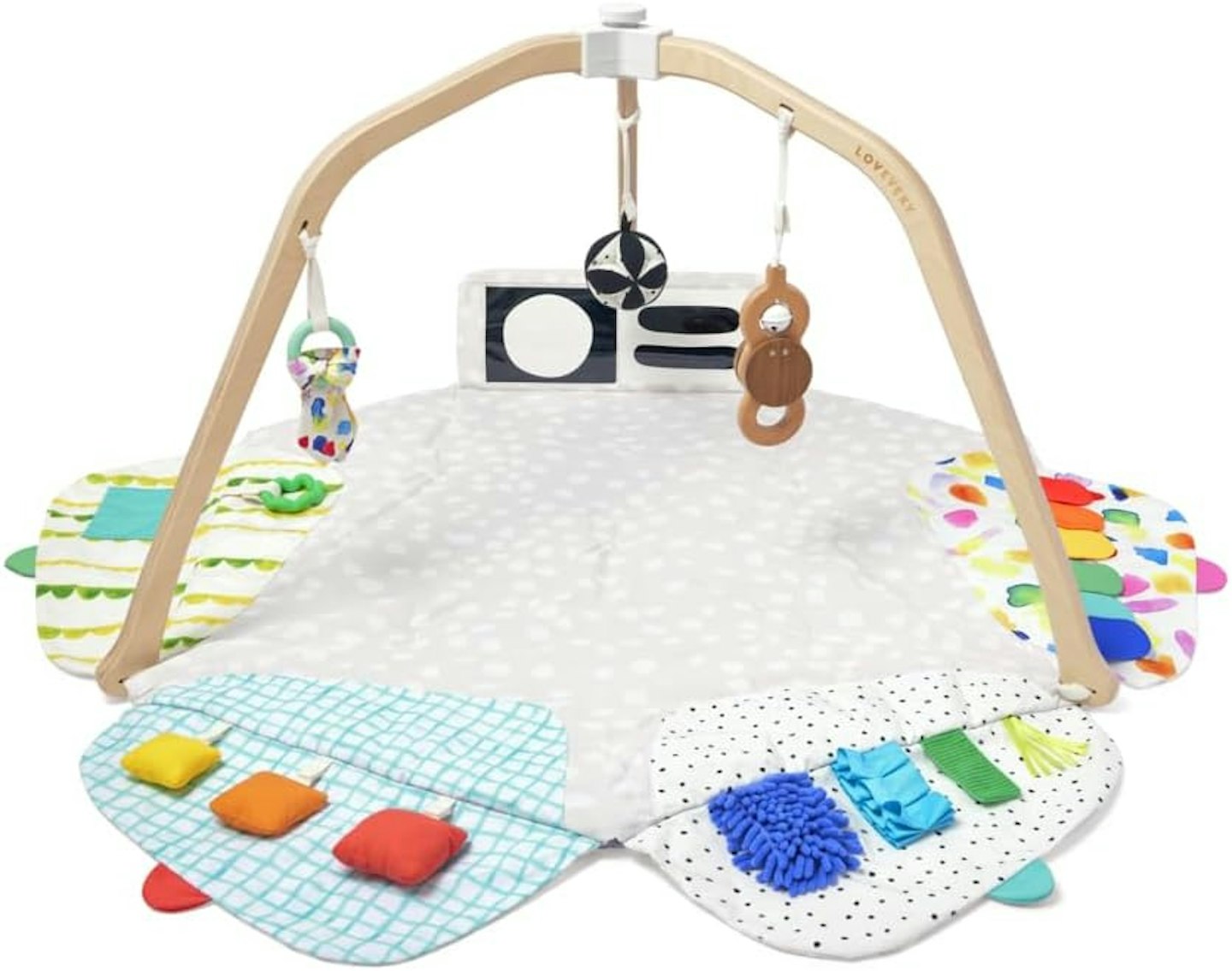Watching your baby grow and become more mobile is a thrilling experience, though it can also be a bit daunting! Before you know it, you’ll have a crawling baby, and soon after, a walking one! It's time to start baby-proofing your house. But first, one key milestone many parents look forward to is when do babies roll.
We spoke with child expert Dr Amanda Gummer, a neuropsychologist and founder of The Good Play Guide, to learn about when babies start rolling over, what to expect, how to encourage this milestone, and what to do if your baby isn’t rolling by a certain age. Plus, we’ve included some favourite toys to help motivate your little one!

What age do babies roll over?
According to Dr Amanda Gummer, neuropsychologist and founder and CEO of The Good Play Guide, “most babies start to roll over between 4 to 6 months of age."
With babies generally start practicing the muscle movements needed to roll over by rocking on their stomachs around five months old. According to the NHS, most babies start to roll at around 6 months old. Some very energetic babies even start to roll as early as three to four months, so watch out!
Initially, they tend to roll from their tummy to their back. Once they master this, they usually learn to roll from their back to their tummy. By eight months, many babies are rolling over with ease.
Signs to watch for when your baby is ready to roll over
As your baby develops, there are several signs indicating they are preparing to roll over. These early indicators can be exciting milestones that show your baby's growing strength and coordination.
Dr Amanda says, "Key developmental milestones indicating readiness include gaining neck and head control, pushing up on their arms during tummy time, and showing increased strength and coordination in their limbs.
Babies often first roll from their stomach to their back, as it requires less muscle strength. Encouraging tummy time and providing a safe, supervised environment can help support your baby’s development and prepare them for this exciting milestone."
When your baby starts to enjoy tummy time
Around three to four months, your baby might start enjoying tummy time more. They will lift their head higher and for longer periods, using their arms to push up. This exercise is crucial for building the neck, shoulder, and arm muscles needed for rolling over.
In addition to preparing them to roll over, regular tummy time also helps prevent flat spots on the back of the baby's head and promotes motor skills development.
When your baby starts to pivot in circles
By four to five months, many babies begin to rock from side to side while lying on their stomachs. You might also notice them pivoting in a circle, using their arms and legs to push off the floor. This movement helps them practice the coordination needed for rolling.
When your baby starts to kick vigorously
Frequent and vigorous leg kicking is another sign. Babies often kick their legs when lying on their back or during tummy time, building the leg strength necessary for rolling over.
When your baby starts to reach for toys
Your baby may start reaching out for toys and other objects around them. This reaching and grasping action not only develops hand-eye coordination but also helps them learn how to shift their weight, an important component of rolling over.
When your baby starts to arch their back
When on their back, babies might arch their back and lift their hips, often rolling onto their side. This movement indicates they are exploring the motion needed to complete a roll.
Creating a safe space for practice
To support your baby during this learning phase, create a safe and comfortable environment. A blanket on the floor or a padded play mat provides a soft surface for your baby to practice rolling over. Ensure the area is free of obstacles and always supervise your baby during tummy time and rolling over attempts to prevent any accidents.
By recognising these signs and providing a supportive environment, you can help your baby achieve the rolling over milestone confidently and safely.
How to encourage your baby to roll over
Helping your baby develop the strength and coordination to roll over can be fun and engaging. Here are a few tips to encourage rolling over.

Tummy time
Ensure your baby gets plenty of tummy time, as it strengthens the muscles needed for rolling over. Pediatricians recommend that by about 2 months of age, babies be getting 15 to 30 minutes of total tummy time daily. This can be broken into smaller sessions (e.g., 5–10 minutes multiple times a day).
Tummy time is essential for:
-
Strengthening neck, shoulder, and core muscles.
-
Reducing the risk of flat head syndrome (positional plagiocephaly).
Parents can start with just a few minutes of tummy time when the baby is a newborn and gradually increase as the baby grows stronger.
Demonstrate rolling
Gently help your baby roll from side to side and then onto their back to show them how it's done.
Interactive play
Lie down on your tummy in front of your baby and use hand or finger puppets to create a story. Move the puppets around to encourage your baby to lift their head and follow the movements, which helps develop the muscles required for rolling.
Encouraging position
Position yourself on one side of your baby to encourage them to roll towards you. Move to the other side and repeat, rewarding them with their favorite toy when they manage to roll over.

Should parents be concerned if their baby rolls over very early? What are the warning signs to look for?
Most early rolling is a normal variation in development and not a cause for alarm. However, parents should observe for:
-
Asymmetrical movement: One side of the body is stronger or moves more than the other.
-
Uncontrolled or jerky movements: This may suggest abnormal reflexes or tone.
-
Developmental delays: Other milestones, such as smiling or head control, are not achieved within the expected timeframes.
If these signs are present, parents should consult their paediatrician.
Does rolling over early indicate cerebral palsy?
Rolling over early doesn’t always mean a baby has cerebral palsy, but it could be an indicator in some cases according to Medical News Today. Early rolling can sometimes result from hypertonia (increased muscle tone) or differences in reflexes, which are associated with cerebral palsy.
Key points for parents to consider:
-
Early rolling is usually not a concern if the baby has otherwise typical muscle tone, reflexes, and movement patterns.
-
However, if early rolling is accompanied by:
-
Stiff or tight muscles
-
Difficulty moving arms or legs symmetrically
-
Persistent primitive reflexes (e.g., Moro reflex beyond 6 months)
-
Delayed or abnormal development in other areas (like feeding or smiling)
Parents should consult a pediatrician or developmental specialist for further evaluation.
Baby not rolling over at 6 months
It's important to remember that babies develop at their own pace, and it is perfectly normal for some to take a bit longer to hit milestones like rolling over.
According to the NHS, if they can't roll to either side by around six months and you’ve tried all of these techniques but you’re still not seeing any improvement after a few months, please speak to your health visitor or GP.
Dr Amanda says, “It's normal for some babies to roll over earlier or later than the average four to six months. Factors like premature birth, muscle tone variations, and individual developmental pace can influence this timeline. If a baby hasn't shown any signs of attempting to roll over by six months, it’s advisable to consult a health visitor or doctor.
Early intervention is key, and professionals can provide exercises and guidance to support your baby’s motor development. Always remember, each baby develops at their own pace, but it's important to seek advice if you have concerns.”
What can parents do when babies roll over when they sleep?
Dr Amanda says, “Always place your baby on their back to sleep, but if they roll over on their own, it's generally okay to leave them in that position. Ensure your baby’s sleep environment is safe by placing them on a firm mattress with a fitted sheet and avoiding loose bedding, pillows, or stuffed animals. To reduce the risk of SIDS, make sure your baby’s crib is free from any suffocation hazards.”
After a baby starts rolling over, what typically comes next in their development?
After rolling over, babies often progress to the following milestones:
Sitting up: Around 4–7 months, babies learn to sit independently by developing trunk and neck control.
Crawling: Between 7–10 months, rolling builds core strength that enables crawling. Some babies skip crawling and transition to scooting or cruising.
Pulling to stand and cruising: After crawling, babies often start pulling themselves to stand using furniture, eventually cruising around while holding onto objects.
These milestones can vary, as each baby develops at their own pace.

Are there specific tools or toys that can encourage babies to roll over?
Yes, the following tools and toys can help encourage rolling:
Tummy time mats: Brightly coloured mats with engaging textures and toys to keep the baby interested.
Rattles and sensory toys: Place these just out of reach to motivate the baby to reach and roll.
Mirrors: Babies are fascinated by their reflections, which can encourage movement.
Soft play balls: Rolling a ball nearby can prompt the baby to track it visually and roll towards it.
Expert tip:
-
Position toys slightly to the side of the baby during tummy time to encourage them to roll in that direction.
-
Use plenty of praise and positive reinforcement to make the experience enjoyable.
Toys to encourage baby to roll over
To support your baby's development and ensure they have a safe environment to practice rolling over, consider these products.
 Very
Very www.very.co.uk
This interactive play gym encourages movement with lights, sounds, and toys. We love this because the piano keys at the base of the gym encourage your baby to kick, which strengthens leg muscles. The hanging toys above stimulate reaching and grasping, promoting upper body strength necessary for rolling.
One parent review said: "Fabulous product. Wonderful for tummy time. My child is 2months old and plays with it everyday. I only wish the songs would shuffle and not play in the same order."
Pros
- Stimulates sensory development
- Adjustable arches for various play modes
- Encourages both upper and lower body movement
Cons
- Requires batteries
- Can be bulky
 Amazon
AmazonSuitable from birth onwards, the penguin tummy time pillow cuddles your little one as they enjoy tummy time, and it includes polar bear teddies and a super cute penguin teddy with a mirror on its tummy. The different fabrics such as crinkle face, satin ears and soft plush arms make it fun for you baby to explore different textures.
A reviewer said: "I dread doing tummy time with my daughter because I see how uncomfortable it is for her and makes her cry so much. To be honest I didn't expect this pillow to make a difference but wow it has! As soon as I put her on it she popped her head up straight away and was smiling! She now enjoys tummy time and we both no longer dread it. The toys are great and I love the neutral colours. It's also really soft and feels nice. I would definitely recommend this. Big thumbs up from us!"
Pros
- Safe for newborns
- Lightweight and portable
Cons
- Not suitable for tumble drying
 Amazon
AmazonWe love this pillow and activity mat because it's plush and padded, ensuring the baby is comfy. The pillow helps elevate the baby’s chest, making it easier to reach for toys and practice rolling over.
One review said: "Really cute design, perfect for encouraging tummy time for the little one or to just have a chill and play."
Pros
- Supports chest elevation, includes engaging toys, soft and plush material.
Cons
- May not be suitable as the baby grows

One of the most loved playgyms for its quality, the Loveevery Play Gym includes high-contrast cards and a variety of textures to stimulate your baby's senses. It provides an engaging environment for tummy time, which helps build the strength needed for rolling over.
One reviewer said: "This is absolutely a stunning play mat. It can be used from birth and it caters for all developmental needs of babies under one year old. I wish I had it with my first one. But to be frank it will not make your baby calm if they are fussy neither will it make them play independently when they are not ready to do so. So please don’t expect miracles from it. Also this is very expensive play mat and in my opinion it is worth the money if you don’t need to stretch your budget to buy it."
Read our full Lovevery The Play Gym review
Pros
- Includes a range of activities to engage your baby
- Made from sustainably sourced materials
- Grows with your baby from infancy to toddlerhood
Cons
- Higher price point
Every day babies learn new things about the world and about themselves, so this mirror is perfect for tummy time. It encourages your baby to start holding their head up and start to see themselves in the mirror. You can even lay down next to your baby and pull funny faces into the large mirror and watch their little face light up.
One mum reviewer said: "Love this, was using a small make up mirror until my son got more mobile and this is so safe and age appropriate! Great prop to get more mileage from tummy time! You got get as bored when there’s another baby just as confused about being on their tummy looking back at you in consolidation!!! Bought when my son was 14 weeks but wish we had it much sooner!! He really enjoys it. Great buy and there’s a lot of baby products I wouldn’t say that about!"
Pros
- Can be folded down when not in use
- Customers find the mirror to be a good quality product with a clear mirror. They appreciate its sturdy construction and nice design.
Cons
- May get smeared with fingerprints so will need cleaning
About the expert
Dr Amanda Gummer is neuropsychologist with over 20 years of experience in child development and play. She is the founder and CEO of The Good Play Guide, a leading independent review platform for children’s toys, apps, and educational products. Dr. Gummer also established Fundamentally Children, a research consultancy focused on child development and parenting.
About the author
Anne Lora Scagliusi is a Senior Digital Writer at Mother & Baby. She is a Scotland-based journalist with over a decade of international writing experience, specialising in women’s health, maternal mental health, and wellness. Her work has been featured in Vanity Fair, Marie Claire, and Glamour and has appeared on several Vogue global editions. She is mum to a one-year-old bambino and lives between Italy and the UK.

